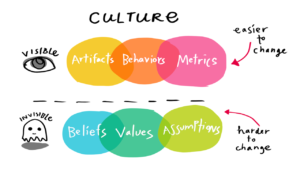Implementing Agile or DevOps? work on the culture first
While tools and methods are important… it is a culture that has the biggest impact. How do you change a culture?
Culture is ingrained within us. It defines who we are. It includes elements such as our language, our food, our values, and our stories. It is extremely hard to change a culture. Countries have cultures. Companies have cultures. Many companies attempt to become DevOps or agile but fail to change their culture. This change must come down from the top and be embraced from the bottom up, in order for the change to happen. This is not an easy thing to do.
How do you change a culture?
You must change the way people think. They have to start thinking differently. You need to think about social coding and sharing. You have to change the way they work. They need to start working differently. Working in small batches and using core values to work for a shared goal.
You must change the way you are organized. This is one a lot of companies don’t get. You must organize differently because the organization has a direct impact on how you build things. Most of all, you must change the way people are measured. You must change your measurement system and measure differently because you always get what you measure.
In addition to the points mentioned above, changing the way people think, work, organize and measure also requires a cultural shift within an organization. This cultural shift can be achieved by promoting open communication and transparency, encouraging risk-taking and innovation, and fostering a growth mindset that values continuous learning and improvement.
It’s also important to recognize that changing the culture that has strong roots deep in the heart of any company is not a one-time event. It requires ongoing effort and a willingness to adapt and evolve as new challenges and opportunities arise. To ensure long-term success, organizations need to invest in the development of their employees, provide them with the tools and resources they need to succeed, and create a supportive environment that encourages experimentation and learning.
Ultimately, changing a culture is about creating a more agile and responsive organization that can adapt to changing circumstances and seize new opportunities. By embracing these changes, organizations can position themselves for long-term success in an increasingly dynamic and competitive business landscape.

